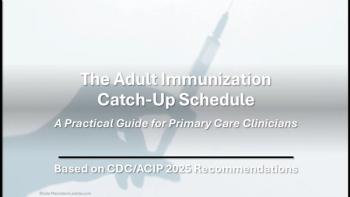
Oncology Q&A
Is prophylactic oophorectomy recommended for healthy postmenopausal women with a strong family history of cancer?
Q: My patient is a healthy postmenopausal woman whose sister recently died of ovarian cancer. Two of her brothers died of lung cancer. She is seeking my advice about a prophylactic oophorectomy. What would you advise?
- MD
A: Women with a known BRCA1 or BRCA2 mutation have a substantial lifetime risk of ovarian cancer: 60% in those with a BRCA1 mutation and 25% in those with a BRCA2 mutation. Prophylactic salpingo-oophorectomy reduces the incidence of ovarian or fallopian tube cancer in such women to between 1.8% and 4% (there is still some risk of cancer even after oophorectomy-thought to result from the peritoneum). The procedure also reduces the incidence of breast cancer by 53% and lowers the risk of recurrent breast cancer (Table). However, if a woman does not carry a BRCA1 or BRCA2 mutation, the risks associated with surgery outweigh the risk of ovarian cancer.
ROLE OF GENETIC TESTING
To determine whether a patient has the BRCA1 or BRCA2 mutation, genetic testing is required. Testing in Ontario-and other places-is normally initiated in a family member in whom breast or ovarian cancer has been diagnosed-who in this case would have been the patient's sister.1 If a BRCA1 or BRCA2 mutation is found in the affected member, then unaffected relatives become candidates for testing.
In Ontario-and other places-there is only one setting in which women who do not have a history of cancer may be considered candidates for testing without confirmation that another family member is mutation- positive. This is a situation in which a family history of breast or ovarian cancer is overlaid on an ethnic heritage with an established predisposition for BRCA-positive tumors (eg, an Ashkenazi Jewish background) and testing cannot be conducted in an affected family member. Because of the cost of genetic testing for cancer-and the potential psychological ramifications-testing is not recommended in persons who are unlikely to have a mutation.
WHAT MIGHT BE WARRANTED IN THIS PATIENT
It is not clear from the information presented whether this patient's sister underwent genetic testing. If the sister's BRCA status is not known, a rough estimate of the patient's ovarian cancer risk can be made based on the family history and any information available about the nature of the sister's cancer.
The history of lung cancer in her brothers is probably the result of environmental exposure. (If appropriate, the patient should be counseled about smoking cessation.) With ovarian cancer, only the epithelial tumors are known to have a familial link-and only 15% of epithelial tumors have such a link. Serous tumors are particularly likely-more so than other histologic types-to be familial. If the sister's tumor was epithelial (the worst-case scenario), the patient's risk of ovarian cancer is 3.1%, or 1 in 32, which is only slightly higher than the risk in the general population (1.5%, or 1 in 70). Whether, given these odds, the risks associated with oophorectomy outweigh the risk of ovarian cancer developing must be determined on an individual basis.
PROS AND CONS OF OOPHORECTOMY
Patients should review the benefits and risks of prophylactic surgery with a gynecologist or gynecologic oncologist. The risks include those associated with the surgery, such as bleeding, infection, and thromboembolic disease. Long-term sequelae may include possible changes in libido resulting from the loss of the ovaries. It is also important to discuss which organs would be removed as part of the procedure (ie, fallopian tubes and ovaries with or without the uterus). Finally, the risks and benefits of various surgical approaches (eg, laparoscopic, laparoscopically assisted vaginal hysterectomy, total abdominal hysterectomy with bilateral salpingo-oophorectomy) need to be reviewed.
Other factors that would play a role in the decision to perform salpingo-oophorectomy include whether the patient requires abdominopelvic surgery for another reason. If she does, her ovaries and tubes could be removed as part of the already indicated procedure.
Generally, oophorectomy is only considered in patients who have a documented BRCA1 or BRCA2 mutation or a personal history of breast or ovarian cancer or hereditary nonpolyposis colon cancer.
References:
REFERENCES:
1.
Fergus K. Breast and ovarian cancer: considering genetic testing. Available at:
http://www.genetichealth.com/BROV_Genetic_Testing_for_Breast_and_Ovarian_Cancer.shtml
. Accessed April 20, 2006.
2.
Rosen B, Kwon J, Fung MFK, et al. Management options for women with a hereditary predisposition to ovarian cancer.
Cancer Care Ontario Program in Evidence-Based Care.
2003;4-4:1.
3.
Kauff ND, Satagopan JM, Robson M, et al. Risk-reducing salpingo-oophorectomy in women with a
BRCA1
or
BRCA2
mutation.
N Engl J Med.
2002;346:1609-1615.
4.
Rebbeck TR, Lynch HT, Neuhausen SL, et al. Prophylactic oophorectomy in carriers of
BRCA1
and
BRCA2
mutations.
N Engl J Med.
2002;346:1616-1622.
5.
Struewing P, Watson P, Easton DF, et al. Prophylactic oophorectomy in inherited breast/ovarian cancer families.
J Natl Cancer Inst Monogr.
1995;17:33-35.
Newsletter
Enhance your clinical practice with the Patient Care newsletter, offering the latest evidence-based guidelines, diagnostic insights, and treatment strategies for primary care physicians.














































































































































































































































































































